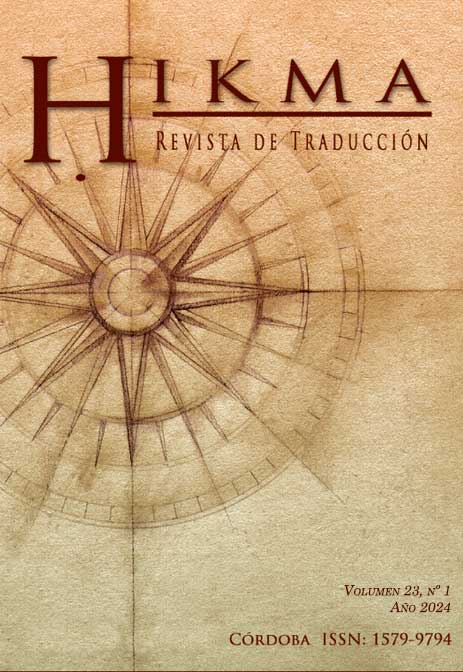ZÁRATE, Soledad. Captioning and Subtitling for d/Deaf and Hard of Hearing Audiences. London, UCL Press, 2021, 154 pp., 978-1-78735-712-9.
Contenido principal del artículo
Resumen
Reseña del libro: Captioning and Subtitling for d/Deaf and Hard of Hearing Audiences.
Descargas
Detalles del artículo

Esta obra está bajo una licencia internacional Creative Commons Atribución-NoComercial-CompartirIgual 4.0.
Los autores que publican en esta revista aceptan las siguientes condiciones:
- Los autores conservan los derechos de autor y conceden a la revista el derecho de primera publicación con el trabajo simultáneamente bajo una Licencia de Atribución Creative Commons que permite a otros compartir el trabajo con un reconocimiento de la autoría del trabajo y la publicación inicial en esta revista.
- Los autores pueden llegar a acuerdos contractuales adicionales por separado para la distribución no exclusiva de la versión publicada del trabajo en la revista (por ejemplo, enviarlo a un repositorio institucional o publicarlo en un libro), con un reconocimiento de su publicación inicial en esta revista.
- Se permite y anima a los autores a publicar sus trabajos en línea (por ejemplo, en repositorios institucionales o en su sitio web) antes y durante el proceso de presentación, ya que puede dar lugar a intercambios productivos, así como a una citación más temprana y mayor del trabajo publicado (Véase El efecto del acceso abierto).
Citas
Agulló, B., & Matamala, A. (2019). Subtitling for the deaf and hard-of-hearing in immersive environments: Results from a focus group. The Journal of Specialised Translation, 32, 217-235.
Arnáiz, V. (2012). Los parámetros que identifican el subtitulado para sordos: Análisis y clasificación. MonTI. Monografías de Traducción e Interpretación, 4, 103–132. https://doi.org/10.6035/MonTI.2012.4.5 DOI: https://doi.org/10.6035/MonTI.2012.4.5
De Linde, Z., & Kay, N. (1999). The Semiotics of Subtitling. St Jerome.
Díaz-Cintas, J., & Remael, A. (2021). Subtitling: Concepts and practices. Routledge. DOI: https://doi.org/10.4324/9781315674278
Ivarsson, J., & Carroll, M. (1998). Subtitling. TransEdit.
Ley 13/2022, de 7 de julio, General de Comunicación Audiovisual., 13/2022 Boletín Oficial de Estado, 163, de 8 de julio de 2022. https://www.boe.es/eli/es/l/2022/07/07/13/con
Miquel-Iriarte, M. (2017). The reception of subtitling for the deaf and hard of hearing: Viewers’ hearing and communication profile & subtitling speed of exposure. [Doctoral dissertation, Universitat Autònoma de Barcelona].
Neves, J. (2005). Audiovisual translation: Subtitling for the deaf and hard-of-hearing. [Doctoral dissertation, University of Roehampton].
Palacios, A. (2008). El modelo social de discapacidad: Orígenes, caracterización y plasmación en la Convención Internacional sobre los derechos de las personas con discapacidad. Cinca.
Romero-Fresco, P. (Ed.). (2015). The reception of subtitles for the deaf and hard of hearing in Europe. Peter Lang. DOI: https://doi.org/10.3726/978-3-0351-0888-0
Romero-Fresco, P., & Fresno, N. (2023). The accuracy of automatic and human live captions in English. Linguistica Antverpiensia, New Series: Themes in Translation Studies, 22, 114–133. https://doi.org/10.52034/lans-tts.v22i.774 DOI: https://doi.org/10.52034/lans-tts.v22i.774
Sala, È. (2022). Rendering tone and mood in creative subtitles for deaf and hard-of-hearing: A proposal. Między Oryginałem a Przekładem, 28(1 (55), 73–91. https://doi.org/10.12797/MOaP.28.2022.55.04 DOI: https://doi.org/10.12797/MOaP.28.2022.55.04
Szarkowska, A. (2020). Subtitling for the deaf and the hard of hearing. In Ł. Bogucki & M. Deckert (Eds.), The Palgrave Handbook of Audiovisual Translation and Media Accessibility (pp. 249–268). Springer International Publishing. https://doi.org/10.1007/978-3-030-42105-2_13 DOI: https://doi.org/10.1007/978-3-030-42105-2_13
Wilmington, A. (2017). Deaf like me. Engaging ‘hard to reach’ deaf audiences through theatre. Red Earth Theatre.
Zárate, S. (2014). Subtitling for deaf children: Granting accessibility to audiovisual programmes in an educational way. [Doctoral dissertation, University College London].

